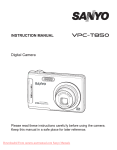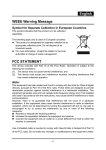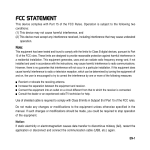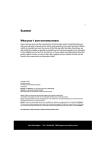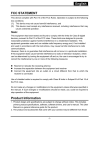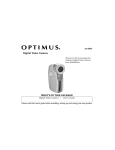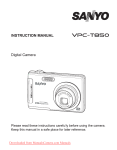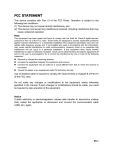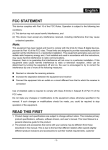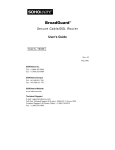Download Untitled
Transcript
FCC STATEMENT This device complies with Part 15 of the FCC Rules. Operation is subject to the following two conditions: (1) This device may not cause harmful interference, and (2) This device must accept any interference received, including interference that may cause undesired operation. Note: This equipment has been tested and found to comply with the limits for Class B digital devices, pursuant to Part 15 of the FCC rules. These limits are designed to provide reasonable protection against harmful interference in a residential installation.This equipment generates uses and can radiate radio frequency energy and, if not installed and used in accordance with the instructions, may cause harmful interference to radio communications. However, there is no guarantee that interference will not occur in a particular installation. If this equipment does cause harmful interference to radio or television reception, which can be determined by turning the equipment off and on, the user is encouraged to try to correct the interference by one or more of the following measures: Reorient or relocate the receiving antenna. Increase the separation between the equipment and receiver. Connect the equipment into an outlet on a circuit different from that to which the receiver is connected. Consult the dealer or an experienced radio/TV technician for help. Use of shielded cable is required to comply with Class B limits in Subpart B of Part 15 of the FCC rules. Do not make any changes or modifications to the equipment unless otherwise specified in the manual. If such changes or modifications should be made, you could be required to stop operation of the equipment. Notice If static electricity or electromagnetism causes data transfer to discontinue midway (fail), restart the application or disconnect and connect the communication cable (USB, etc.) again. EN-1 Notice If static electricity or electromagnetism causes data transfer to discontinue midway (fail), restart the application or disconnect and connect the communication cable (USB, etc.) again. This product contains electrical or electronic materials. The presence of these materials may, if not disposed of properly, have potential adverse effects on the environment and human health. Presence of this label on the product means it should not be disposed of as unsorted waste and must be collected separately. As a consumer, you are responsible for ensuring that this product is disposed of properly. To find out how to properly dispose of this product, please go to www.polaroid.com and click on "Company" or call the customer service number for your country listed in the instruction manual. EN-2 READ THIS FIRST Trademark Information Microsoft® and Windows® are U.S. registered trademarks of Microsoft Corporation. Pentium® is a registered trademark of Intel Corporation. Macintosh is a trademark of Apple Computer, Inc. SD™ is a trademark. Other names and products may be trademarks or registered trademarks of their respective owners. Product Information Product design and specifications are subject to change without notice. This includes primary product specifications, software, software drivers, and user’s manual. This User Manual is a general reference guide for the product. The product and accessories that come with your camera may be different from those described in this manual. This is due to the fact that different retailers often specify slightly different product inclusions and accessories to suit their market requirements, customer demographics, and geographical preferences. Products very often vary between retailers especially with accessories such as batteries, chargers, memory cards, cables, pouches, and language support.!Occasionally a retailer will specify a unique product color, appearance, and! internal memory capacity. Contact your dealer for precise product definition and! included accessories. The illustrations in this manual are for the purpose of explanation and may differ from the actual design of your camera. The manufacturer assumes no liability for any errors or discrepancies in this user manual. EN-3 SAFETY INSTRUCTIONS Read and understand all Warnings and Cautions before using this product. Warnings If foreign objects or water have entered the camera, turn the power off and remove the batteries. Continued use may cause an injury. Please call our friendly customer service for assistance. If the camera has been dropped or its case has been damaged, turn the power off and remove the batteries. Continued use may cause an injury. Please call our friendly customer service for assistance. There is no user serviceable parts; DO NOT DISSASSEMBLE! For repair, please call our friendly customer service for assistance. Do not use the camera in areas near water. Take special care during rain, snow, on the beach, or near the shore. Exposing the camera to these conditions may cause damage to it. Do not place the camera on unstable surfaces. This might cause the camera to fall or tilt over, causing damage. Keep the batteries out of the reach of children. Batteries should only be replaced by an adult. Children must be supervised by an adult when they are replacing the batteries. Do not use the camera while you are walking, driving or riding a motorcycle. This might cause personal injury or result in traffic accident. EN-4 Cautions Load the batteries paying careful attention to the polarity (+ or –) of the terminals. Loading the batteries with their polarities inverted might cause fire and injury, or damage to the surrounding areas due to the battery rupturing or leaking. Do not fire the flash close to anyone’s eyes. This might cause damage to the person’s eyesight. Do not subject the LCD monitor to impact. This might damage the glass on the screen or cause the internal fluid to leak. If the internal fluid enters or contacts your eyes, rinse with fresh water. If the fluid contacts you clothing rinse with water and seek medical attention immediately. A camera is a precision instrument. Do not drop, strike, or use excessive force when handling the camera. This might cause damage to the camera. Do not use the camera in humid, steamy, smoky, or dusty places. This might cause fire or electric shock. Do not remove the batteries immediately after a long period of continuous use. The batteries may become warm and possibly cause an injury. Do not wrap the camera or place it in cloth or blankets. This might cause heat to build up and deform the case. Use the camera in a well-ventilated place. Do not leave the camera in places where the temperature may rise significantly, such as inside a car. This might adversely affect the case or the parts inside. Before you move the camera, disconnect cords and cables. Failure to do this might damage cords and cables. EN-5 Using Your Batteries Our laboratory testing has shown that our digital camera models comply with industry standard battery consumption levels (Camera & Imaging Products Association commonly known as CIPA). All digital cameras are high drain products. For the best performance and prolonged battery life, we recommend the use of high capacity batteries designed for such applications. Here are some helpful hints to extend battery life considerably by limiting the following activities: Reviewing the pictures on the LCD Screen Using the optical viewfinder (if your camera has one) to frame the subject when taking pictures Excessive use of the flash Remove batteries from your camera when not in use. WARNING! Batteries should be replaced by an adult. Use recommended or equivalent type of batteries only. Insert the batteries in the correct orientation. Remove exhausted batteries from the camera immediately. Do not short the supply terminals. Please dispose of the batteries properly. These instructions should be retained for future reference. Questions? Call our toll-free customer service number. Look for the insert with this icon: Or visit www.polaroid.com. EN-6 Contents 8 INTRODUCTION 8 8 Overview Package Contents 9 GETTING TO KNOW YOUR CAMERA 9 Front View 10 Rear View 11 LCD Monitor Display 13 GETTING STARTED 13 14 14 15 15 Preparation Turning the Power On/Off LED Indicators Choosing the Language Formatting the Memory Card or Internal Memory 32 TRANSFERRING FILES TO YOUR COMPUTER 32 Downloading Your Files 33 EDITING SOFTWARE INSTALLATION 34 USING THE CAMERA AS A PC CAMERA 34 Install the PC camera driver 35 SPECIFICATIONS 36 APPENDIX 36 Possible Number of Shots 37 Troubleshooting 38 Connecting to a PictBridge Compliant Printer 16 CAPTURE MODE 16 16 17 18 19 Capturing Images Using the Zoom Function Setting Focus Setting the Scene Mode Adjusting the Exposure (EV Compensation) 20 VIDEO MODE 20 Recording Video Clips 21 Playing Back Video Clips 22 PLAYBACK MODE 22 23 23 24 25 Playing Back Still Images Thumbnail Display Slideshow Display Protecting Images Erasing Images 26 MENU OPTIONS 26 28 29 30 Capture Menu Video Menu Playback Menu Setup Menu EN-7 INTRODUCTION Overview Congratulations on your purchase of your new Polaroid digital camera. Capturing high-quality digital images is fast and easy with this state-of-the-art smart camera. Equipped with a 5.0-megapixel sensor, this camera is capable of capturing images with a resolution of up to 2560 x 1920 pixels. Package Contents Carefully unpack your camera and ensure that you have the following items: Common Product Components: Digital Camera User’s manual Software CD-ROM USB cable Camera strap Camera pouch 2 x AAA size batteries Common (Optional) Accessories: SD/SDHC memory card (We recommend the use of a Polaroid memory card up to 4 GB.) Accessories and components may vary by retailer. EN-8 GETTING TO KNOW YOUR CAMERA Front View 1 2 3 4 5 6 7 8 1. Shutter button 2. Power button 3. Flash 4. Focus switch Normal mode Macro mode 5. Lens 6. Beeper 7. USB connector 8. Self-timer LED EN-9 Rear View 1 2 3 4 5 6 9 8 7 1. LCD monitor 7. Battery door 2. Status LED 8. SD/SDHC memory card slot 3. OK OK button Digtal Zoom button 9. Tripod socket 4. Strap holder 5. 4-way control button Up button S MENU Menu button X Right button Flash button Down button T MODE Mode button Left button W Self-timer button 6. EN-10 Playback button LCD Monitor Display 1. Mode indicator [ ] Auto Mode [ ] Sport Mode [ ] Night Mode [ ] Portrait Mode [ ] Landscape Mode [ ] Backlight Mode 2. Flash mode [ ] Auto Flash [ ] Always On [ ] Flash Off 3. Battery Power Level [ ] Full battery power [ ] Medium battery power [ ] Low battery power [ ] No battery power 4. Storage media [ ] Internal memory (no card) [ ] SD/SDHC memory card 5. Image size resolution [10m]3648 x 2736 (FW interpolation) [8m]3264 x 2448 (FW interpolation) [5m]2560 x 1920 [3m]2048 x 1536 [1.3m]1280 x 960 [VGA]!640 x 480 6. Image quality [ ] Fine [ ] Standard [ ] Economy 7. Available number of shots 8. Main focus area 9. Self-timer icon [ 10s] 10 sec. [ 2s] 2 sec. 1 2 3 A 4 14 13 12 11 10 10s +0.3 ISO 200 9 5m 5 00154 6 7 8 10. ISO [ ] Auto [ ] 100 [ ] 200 ] Exposure compensation 11. [ 12. Metering [ ] Average [ ] Spot 13. White Balance [Blank] Auto [ ] Daylight [ ] Cloudy [ ] Tungsten [ ] Fluorescent 14. Focus setting [Blank] Normal [ ] Macro EN-11 Video mode [S] 1. 2. 3. 4. 5. 6. 7. 8. 9. Video indicator icon Available recording time Main focus area Battery level Storage media Video resolution Exposure compensation White Balance Focus setting 1 4 3 59:59 5 9 8 VGA 7 6 +0.3 Playback mode![x]!-! Still image playback 1. 2. 3. 4. 5. 6. 2 1 2 Playback indicator Battery level Storage media File number Folder number Protect icon 3 100-0001 6 Playback mode![x]!-!Video playback 1. 2. 3. 4. 5. 6. 7. 8. 9. 1 2 Playback indicator Mode icon Total recorded time Battery level Storage media Video resolution File number Folder number Playback indicator 3 4 4 00:11 5 VGA 100-0001 9 EN-12 5 8 7 6 GETTING STARTED Preparation 1. Attach the camera strap. 2. Open the battery door. 3. Load the batteries with correct orientation as shown. 4. Close the battery door and make sure it is locked securely. 5. Insert an SD/SDHC memory card (Optional). The camera has 16MB internal memory (13.5MB available for image storage), but you can load an SD/SDHC memory card (SDHC memory card up to 4GB) to expand the camera’s memory capacity. Be sure to format the memory card with this camera before its initial usage. To prevent valuable data from being accidentally erased from an SD/ SDHC memory card, you can slide the write protect tab (on the side of the SD/SDHC memory card) to “LOCK”. To save, edit, or erase data on an SD/SDHC memory card, you must unlock the card/ To prevent damaging of an SD/SDHC memory card, be sure to turn off the power when inserting or removing the SD/SDHC memory card. If inserting or removing the SD/SDHC memory card with the power on, the camera will automatically turn off. Be careful not to drop the batteries when opening or closing the battery door. EN-13 Turning the Power On/Off Press the POWER button until the digital still camera turns on. To turn the power off, press the POWER button again. To save battery life, the power is turned off automatically when the camera has not been operated for a fixed period of time. To resume the operation condition, turn the power on again. Refer to section in this manual titled “Auto Off” in the Setup Menu for further details. LED Indicators Indicators State Description/Activity LED indicator Solid green The digital camera is powering up. LED indicator Solid green The digital camera is ready to record images (or movies). LED indicator Blinking green Reading/Writing files. LED indicator Blinking green Charging the flash. Self-timer indicator Blinking red The self-timer function is activated. Questions? Call our toll-free customer service number. Look for the insert with this icon: Or visit www.polaroid.com. EN-14 Choosing the Language Specify in which language menus and messages are to be displayed on the LCD monitor. 1. Press the MENU button. 2. Select [Setup] menu with the f button. 3. Select [Language] with the c / d buttons, and press the OK button. The Language setting screen will be displayed. 4. Select the displayed language with the c / d buttons, and press the OK button. The setting will be stored. Setup HZ Format Beep Language Auto Off Sys. Reset Light Freq. Next Menu On English 3 Min. Next Menu 50Hz To exit from any menu selection, press the W button. Formatting the Memory Card or Internal Memory This utility formats the internal memory (or memory card) and erases all stored images and data. 1. Press the MENU button. 2. Select [Setup] menu with the f button. 3. Select [Format] with the c / d buttons, and press the OK button. 4. Select [Execute] with the c / d buttons, and press the OK button. To cancel formatting, select [Cancel] and press the OK button. Setup HZ Format Beep Language Auto Off Sys. Reset Light Freq. Next Menu On English 3 Min. Next Menu 60Hz Format Cancel Execute EN-15 CAPTURE MODE Capturing Images Your camera is equipped with a 2.48" full color LTPS-TFT LCD monitor to help you compose images, playback recorded images/video clips or adjust menu settings. 1. Press the Power button to turn the power on. The status LED lights green and the camera is initiated. 2. Compose the image on the LCD monitor so that the main subject is within the focus frame. Pressing the OK / button zooms in on the subject, and enlarges the subject on the LCD monitor. 3. Press the shutter button to capture the image. Using the Flash The flash is designed to function automatically when lighting conditions permit the use of flash. The camera has 3 flash modes: Flash Off, Auto Flash, and Always On. You can take an image using a desired flash mode to suit your circumstances. The flash’s effective range is 0.9m (35.4”) ~ 1.5m (59.1”) (in Normal mode). The flash function is disabled if the camera is set to Macro mode. 1. Press the Power button to turn the power on. 2. Toggle until your desired flash mode appears on the LCD monitor. 3. Compose your scene and press the shutter button to capture the image. The table below will help you to choose the appropriate flash mode: Flash mode Description Flash Off Use this mode in the environment that the flash use is prohibited or under the situation that the distance to the subject is too far away for the flash to have any effect. Auto Flash The flash fires automatically according to suit the photographic conditions. Always On The flash will always fire regardless of the surrounding brightness. Select this mode for recording images with high contrast (backlighting) and deep shadows. EN-16 Using the Zoom Function This camera is equipped with 4x digital zoom. You can enlarge the subjects by pressing the OK / button. A useful feature as it is, however, the more the image is magnified, the grainer the image may become. To capture a zoomed image, perform the following steps: 1. Press the Power button to turn the power on. 2. To activate the digital zoom, press the OK / button. The status of digital magnification is displayed on the LCD monitor. 3. Compose your scene and press the shutter button to capture the image. The digital magnification ranges from 1.0x to 4.0x. As you record video clips, the zoom function cannot be activated. Image color noise (grain) may occur in the recorded image when using the digital zoom feature. EN-17 Setting Focus Images can be captured by sliding the focus switch to set the focus modes: [ ] macro or [ ] normal mode. The focus range of marco mode is 0.6m (23.6”) ~ 1.45m (57.1”); normal mode is 1.45m (57.1”) ~ Infinity. 1. Press the Power button to turn the power on. 2. Slide the focus switch to your desired focus mode. 3. Compose your scene and press the shutter button. The table below will help you choose the appropriate focus mode: Focus mode Description Normal This mode is suitable for scenery and portrait shooting. Macro Select macro to capture close-up images. When the lens is zoomed to its widest position you may focus objects as close as 0.6 m (23.6”). If the camera is set to Macro mode, the flash function is disabled. EN-18 Setting the Scene Mode You can select the scene mode according to image your wish to capture. There are 6 available modes in this scene mode. [ ] Auto: Select this mode for most picture taking situations. [ ] Sport: Select this mode when you want to photograph fast-moving subjects. [ ] Night: Select this mode when you want to capture dark scenes such as night views. [ ] Portrait: Select this mode when you want to capture an image that makes the person stand out against a defocused (blurred) background. [ ] Landscape: Select this mode to capture an image with infinity focus, hard sharpness and high saturation. [ ] Backlight: Select this mode when you want to capture images as the light comes from behind the object. 1. Press the MENU button. The [Capture] menu is displayed. 2. Select [Scene Mode] with the S / T buttons, then press the OK button. 3. Select the desired scene mode with the S / T buttons, then press the OK button. 4. To exit from the menu, press the W button. Capture Size Quality Scene Mode EV Metering W. Balance 5M Fine Auto +0.0 Average Auto Ex.: In Camera Mode Scene Mode Auto Sport Night Portrait Landscape Backlight EN-19 Adjusting the Exposure (EV Compensation) You can manually adjust the exposure determined by the digital camera. Use this mode when the proper exposure cannot be obtained, for example, when the contrast (different between light and dark) between the subject and the background is extremely large. The EV compensation value can be set in the range from -2.0EV to +2.0EV. 1. Press the MENU button. The [Capture] or [Video] menu is displayed. 2. Select [EV] with the S / T buttons, then press the OK button. 3. Use S or T to set the range of EV compensation value from -2.0EV to +2.0EV, then press the OK button. 4. To exit from the menu, press the W button. Capture Size Quality Scene Mode EV Metering W. Balance 5M Fine Auto +0.0 Average Auto EV +0.0 Effective Subjects and Set Values +(positive) compensation -(negative) compensation Backlight correction (+0.3 EV, fixed) * When the background is * People illuminated by a * Printed matter with black bright and the subject is spotlight, in particular, text on whitish paper. dark. against dark background. * Backlighting. * When subjects (people) * Printed matter with white * Bright scenes or strong have a light source such text on blackish paper. reflected light such as ski as the sun to their backs. * Weak reflecting bodies such slopes. as evergreen trees or * When the sky accounts for darkish leaves a large area on the screen. EN-20 VIDEO MODE Recording Video Clips This mode allows you to record video clips at a resolution of VGA (640 x 480) / QVGA (320 x 240) pixels. 1. Press the MODE button to set the camera mode to [ ]. 59:59 2. Compose the image. 3. Press the shutter button. The recording of the video clip will start. Pressing the shutter button one more time will end the recording of the video clip. VGA The recording time depends on the +0.3 storage size and the subject of the image to be recorded. When recording a video clip, the flash cannot be used. If the write speed of your SD/SDHC memory card is not fast enough for recording video clips in the!currently selected size, the video recording will stop. In this case, select a video size lower than the current one. The maximum recordable time for one continuous video clip is 00:59:59. Questions? Call our toll-free customer service number. Look for the insert with this icon: Or visit www.polaroid.com. EN-21 Playing Back Video Clips You can play back recorded video clips on the camera. 1. Press the [ ] button. The last image appears on the screen. 2. Select the desired video clip with the e / f buttons. 3. Press the OK button. A press of the f / e buttons during playback allows fast forward play / fast reverse play. To stop video playback, press the d button. This stops playback and returns to the start of the video clip. To pause video playback, press the OK button. This pauses video playback. To cancel pause, press the OK button again. 00:11 VGA 100-0001 Video clips cannot be displayed rotated or enlarged. This camera does not have a built-in speaker and microphone. Audio function is not available. To play the video clip back on your computer, you may use either Windows Media Player or Apple “QuickTime Player”. QuickTime basic player is available free of charge, compatible with Mac and Windows-computers and can be downloaded from the Apple web site at www.apple.com. For help using QuickTime Player usage, please refer to the QuickTime on-line help for more information. EN-22 PLAYBACK MODE Playing Back Still Images You can play back the still images on the LCD monitor. 1. Press the [ ] button. The last image appears on the screen. 2. The images can be displayed in reverse or forward sequence with the e / f buttons. To view the previous image, press the e button. To view the next image, press the f button. 3. Press the OK / button to adjust the zoom ratio. The magnification factor is displayed on the LCD monitor. 4. To view different portion of the images,press the c / d / e / f button to adjust the display area. 2.0X 100-0004 An [ ] icon is displayed with the video data. The magnification factors range from 1x to 4x (within 4 stages: 1.0x, 2.0x, 3.0x, and 4.0x). EN-23 Thumbnail Display This function allows you to view 9 thumbnail images on the LCD monitor simultaneously so you may search for a particular image. 1. Press the [ ] button. The last recorded image appears on the LCD monitor. 2. Press the MENU button. The playback menu is displayed. 3. Select [Thumbnail] with the c / d buttons, then press the OK button. Nine thumbnail images are displayed simultaneously. For recorded video clips, the [ ] video mode icon will be displayed. 4. Use the c / d / e / f button to move the cursor to select the image to be displayed at regular size. 5. Press the OK button to display the selected image on full screen. Slideshow Display The slideshow function enables you to playback your still images automatically in order one image at a time. 1. Press the [ ]!button. Play 2. Press the MENU button. Next Menu Delete The playback menu is displayed. Copy to Card Next Menu 3. Select [Slide Show] with the c / d buttons, Slide Show 3 sec. then press the OK button. Protect 5 sec. 4. Select the desired interval time with the c / d Thumbnail 10 sec. buttons, and press the OK button. The slideshow starts. 5. To stop the slide show during playback, press the OK button. The image is displayed on screen when you press the OK button. The Auto Off function does not operate during slide show. All still images in the folder are automatically played back. Video files are displayed first frame image, and they are not played back. EN-24 Protecting Images Set the data to read-only to prevent images from being erased by mistake. 1. Press the [ ]!button. Play 2. Select the image that you want to protect with the e / f buttons. Next Menu Delete 3. Press the MENU button. Copy to Card Next Menu 4. Select [Protect] with the c / d buttons, and Slide Show 3 sec. press the OK button. Protect Next Menu 5. Select [Single] or [All] with the c / d buttons, Thumbnail Next Menu and press the OK button. [Single]: Protects the selected image or the last image. Protect [All]: Protects all of the images. Single 6. Select [Lock] with the c / d buttons, and press All the OK button. Protection is applied to the image and the camera returns to the previous menu mode. The protect icon [y] is displayed with protected images. When [All] has been selected, [y] is Protect displayed with all the images. Canceling the Protection Single Lock Unlock To cancel protection for only one image, display the image on which you want to remove the image protection. 1. Select [Protect] with the c / d buttons from the playback menu, and press the OK button. 2. Select [Single] or [All] with the c / d buttons, and press the OK button. 3. Select [Unlock] with the c / d buttons, and press the OK button. The removal of image protection is executed and the camera returns to the previous menu mode. Formatting an SD/SDHC memory card or internal memory overrides protection, and erases all images regardless of their protected status. Questions? Call our toll-free customer service number. Look for the insert with this icon: Or visit www.polaroid.com. EN-25 Erasing Images Erasing single image / Erasing all images 1. Press the [ ]!button. The last image will be displayed on the screen. 2. Select the image you want to erase with the e / f buttons. 3. Press the MENU button. 4. Select [Delete] with the c / d buttons and press the OK button. 5. Select [Single] or [All] with the c / d buttons, and press the OK button. [Single]: Erases the selected image or the last image. [All]: Erases all of the images except for the protected images. 6. Select [Execute] with the c / d buttons, and press the OK button. To not erase, select [Cancel], and press the OK button. Play Next Menu Delete Copy to Card Next Menu Slide Show 3 sec. Protect Next Menu Thumbnail Next Menu Delete Single All Delete Delete This File? Cancel Execute Deleting an image will not affect sequential image numbering. For example, if you delete image number 240, the next captured image will be numbered 241 even though 240 no longer exists. In other words, an image-number is retired when an image is deleted and will not be reused or reassigned to another subsequently captured image. EN-26 MENU OPTIONS Capture Menu This menu is for the basic settings to be used when capturing still images. Capture Capture Size Quality Scene Mode EV Metering W. Balance 5M Fine Auto +0.0 Average Auto ISO Color Saturation Sharpness Auto Standard High Hard 1. Press the MODE button to set the camera mode to Camera. 2. Press the MENU button. 3. Select the desired option item with the c / d buttons, and press the OK button to enter its respective menu. 4. Select the desired setting with the c / d buttons, and press the OK button. 5. To exit from the menu, press the e button. Size This sets the size of the image that will be captured. * [10m] 10M (3648 x 2736 pixels) (FW interpolation) 8M (3264 x 2448 pixels) (FW interpolation) * [8m] * [5m] 5M (2560 x 1920 pixels) 3M (2048 x 1536 pixels) * [3m] * [1.3m] 1.3M (1280 x 960 pixels) * [VGA] !VGA (640 x 480 pixels) Quality This sets the quality (compression) at which the image is captured. *[ ] Fine *[ ] Standard *[ ] Economy Scene Mode Refer to section in this manual titled “Setting the Scene Mode” for further details. EN-27 EV Refer to section in this manual titled “Adjusting the Exposure (EV Compensation)” for further details. Metering This sets the metering method for calculating the exposure. * [ o ] Average: The entire area of the screen is measured, and the exposure is calculated. * [ q ] Spot: A very small portion of the center of the screen is measured, and the exposure is calculated. White Balance This sets the white balance for a variety of lighting conditions and permits images to be captured that approach the conditions that are seen by the human eye. * [ Blank ] Auto *[ ] Daylight *[ ] Cloudy *[ ] Tungsten *[ ] Fluorescent ISO This sets the sensitivity for capturing images. When the sensitivity is raised (and the ISO figure is increased), photography will become possible even in dark locations, but the more pixelated (grainier) the image will appear. * Auto / 100 / 200 Color This sets the color of the image that will be captured. * Standard / Vivid / Sepia / B&W Saturation This sets the saturation of the image that will be captured. * High / Normal / Low Sharpness This sets the sharpness of the image that will be captured. * Hard / Normal / Soft EN-28 Video Menu This menu is for the basic settings to be used when recording video clips. Video Size EV W. Balance VGA +0.0 Auto 1. Press the MODE button to set the camera mode to [ w ]. 2. Press the MENU button. 3. Select the desired option item with the c / d buttons, and press the OK button to enter its respective menu. 4. Select the desired setting with the c / d buttons, and press the OK button. 5. To exit from the menu, press the e button. Size This sets the size of the video clip that will be captured. * [VGA] 640 x 480 * [QVGA] 320 x 240 EV Refer to section in this manual titled “Adjusting the Exposure (EV Compensation)” for further details. White Balance Refer to section in this manual titled “White Balance” in Capture Menu for further details. EN-29 Playback Menu In the [ ] mode, choose which settings are to be used for playback. Play Next Menu Delete Copy to Card Next Menu Slide Show 3 sec. Protect Next Menu Thumbnail Next Menu 1. Press the [ ]!button. 2. Press the MENU button. 3. Select the desired option item with the c / d buttons, and press the OK button to enter its respective menu. 4. Select the desired setting with the c / d buttons, and press the OK button. 5. To exit from the menu, press the e button. Delete Refer to section in this manual titled “Erasing Images” for further details. Copy to Card Allows you to copy your files from the camera’s internal memory to an SD/SDHC memory card. Of course, you can only do this if you have a memory card installed and some files in internal memory. * Cancel / Execute Slide Show Refer to section in this manual titled “Slideshow Display” for further details. Protect Refer to section in this manual titled “Protecting Images” for further details. Thumbnail Refer to section in this manual titled “Thumbnail Display” for further details. EN-30 Setup Menu Set your camera’s operating environment. Setup HZ Format Beep Language Auto Off Sys. Reset Light Freq. Next Menu On English 3 Min. Next Menu 60Hz 1. Press the MENU button. 2. Select the [Setup^ menu with the f button. 3. Select the desired option item with the c / d buttons, and press the OK button to enter its respective menu. 4. Select the desired setting with the c / d buttons, and press the OK button. 5. To exit from the menu, press the e button. Format Refer to section in this manual titled “Formatting the Memory Card or Internal Memory” for further details. Beep This sets whether or not to mute the camera sound each time you press the camera's buttons. * On / Off Language Refer to section in this manual titled “Choosing the Language” for further details. Auto Off If no operation is performed for a specific period of time, the power to the camera is automatically turned off. This feature is useful for reducing battery consumption. * 1 Min. / 3 Min. / 5 Min. /Off Questions? Call our toll-free customer service number. Look for the insert with this icon: Or visit www.polaroid.com. EN-31 System Reset This returns all basic settings to the camera’s default settings. * Cancel / Execute Light Freq. The function allows to change the light frequency of environment to 60Hz or 50Hz. * [60Hz]: the light frequency of environment is 60Hz like the US. * [50Hz]: the light frequency of environment is 50Hz like the UK. EN-32 TRANSFERRING FILES TO YOUR COMPUTER System Requirement Windows Pentium 166 MHz or higher Windows 2000/XP/Vista 128MB RAM 128MB hard disk space CD-ROM drive Available USB port Macintosh PowerPC G3/G4/G5 OS 9.0 or later 128MB RAM 128MB hard disk space CD-ROM drive Available USB port Downloading Your Files 1. Connect one end of the USB cable to an available USB port on your computer. 2. Connect the other end of the USB cable to the USB terminal on the camera. 3. Select [PC] using the c / d buttons, and press the OK button. 4. From the Windows desktop, double click on “My Computer”. 5. Look for a new “removable disk” icon. This “removable disk” is actually the memory (or memory card) in your camera. Typically, the camera will be assigned drive letter “e” or higher. 6. Double click on the removable disk and locate the DCIM folder. 7. Double click on the DCIM folder to open it to find more folders. Your recorded images and video clips will be inside these folders. 8. Copy & Paste or Drag-N-Drop image and video files to a folder on your computer. Mac users: Double-click the “untitled” or “unlabeled” disk drive icon on your desktop. iPhoto may automatically launch. EN-33 EDITING SOFTWARE INSTALLATION MediaOne Gallery SE - makes it the easiest way to manage and share your digital life with family & friends. The intuitive thumbnail library automatically organizes, updates and sorts files for the most natural way to browse your multimedia collection. To install software: 1. Insert the CD-ROM that came with the camera into your CD-ROM drive. The welcome screen appears. 2. Click the respective software name. Follow the on-screen instructions to complete the installation. For more information about the operation of the software, refer to its respective help documentation. For Windows 2000/XP/Vista users, please make sure to install and use the software in “Administrator” mode. The software is not supported on the Mac. EN-34 USING THE CAMERA AS A PC CAMERA Your camera can act as a PC camera, which allows you to videoconference with business associates, or have a real-time conversation with friends or family. To use the camera for videoconferencing, your computer system must include the items as below: Microphone Sound card Speakers or headphones Network or Internet connection Install the PC camera driver The PC-camera driver included in the CD-ROM is exclusively for Windows. The PC camera function is not supported for Mac platforms. 1. Insert the enclosed CD-ROM into your CD-ROM drive. 2. Follow the on-screen instructions to complete the installation. 3. After the driver installation is completed, restart your computer. Questions? Call our toll-free customer service number. Look for the insert with this icon: Or visit www.polaroid.com. EN-35 SPECIFICATIONS Item Description Image sensor 1/2.5” CMOS sensor Effective pixels 5.0 Mega pixels Image resolution Still image 10M: 3648 x 2736 (FW interpolation), 8M: 3264 x 2448 (FW interpolation), 5M: 2560 x 1920, 3M: 2048 x 1536, 1.3M: 1280 x 960, VGA: 640 x 480 Video clip VGA: 640 x 480 (24 fps), QVGA: 320 x 240 (30 fps) Recording media 16MB internal memory (13.5MB available for image storage) Supports SD/SDHC memory card (up to 4GB) (optional) File format Image format: JPEG; video format: Motion JPEG Lens F-no.: f 3.0 Focus Length: 6.47 mm (equivalent to 39mm on a 35mm camera) Focus range Macro: 0.6m (23.6”) ~ 1.45m (57.1”) Normal: 1.45m (57.1”) ~ infinity Shutter speed 1 - 1/1000 sec. LCD monitor 2.48” full color LTPS-TFT LCD (153.6K pixels) Self-timer 10 sec delay, 2 sec delay Exposure compensation White balance -2.0EV~ +2.0EV (in 0.3EV increments) Auto, Daylight, Cloudy, Tungsten, Fluorescent ISO Auto, 100, 200 Interface USB connector Power 2 x AAA size batteries (Alkaline or Ni-MH rechargeable batteries) Dimensions Approx. 90 x 55 x 18 mm (without protruding parts) Weight Approx. 82g (without batteries and memory card) * Design and specifications are subject to change without notice. EN-36 APPENDIX Possible Number of Shots Possible number of shots (still image) The table shows the approximate shots that you can capture at each setting based on the capacity of the internal memory and the SD/SDHC memory card. Size 10m 3648 x 2736 (FW interpolation) 8m 3264 x 2448 (FW interpolation) 5m 2560 x 1920 3m 2048 x 1536 1.3m 1280 x 960 VGA 640 x 480 Quality Internal Memory 64MB Fine 3 21 SD/SDHC memory card capacity 128MB 256MB 43 88 512MB 1GB 2GB 178 333 667 4GB SDHC 1336 Standard 5 35 72 145 293 547 1097 2196 Economy 9 55 112 227 456 852 1707 3416 Fine 3 23 48 98 198 370 741 1485 Standard 6 39 80 162 326 608 1219 2440 Economy 10 61 125 252 507 947 1897 3796 Fine 4 28 57 117 235 440 883 1767 Standard 8 46 95 193 388 724 1451 2904 Economy 13 73 149 301 604 1128 2258 4518 Fine 7 44 91 183 369 689 1380 2762 Standard 13 73 150 302 607 1133 2268 4539 Economy 21 115 234 471 945 1763 3529 7061 Fine 21 115 234 472 946 1766 3535 7073 Standard 35 190 386 776 1556 2902 5808 11621 Economy 55 297 601 1207 2421 4515 9036 18078 Fine 88 466 941 1891 3790 7068 14144 28297 Standard 145 766 1547 3107 6228 11612 23238 46489 Economy 226 1193 2407 4834 9689 18064 36148 72317 Possible recording time / sec (video clip) SD/SDHC memory card capacity Size Internal Memory 64MB 128MB 256MB 512MB 1GB VGA 640 x 480 00:14 01:04 02:12 04:27 08:58 QVGA 320 x 240 00:26 02:08 04:21 08:48 17:41 2GB 4GB SDHC 18:00 36:05 01:01:12 35:27 01:11:00 02:22:00 The above data shows the standard testing results. The actual capacity varies according to the shooting conditions and settings. The maximum recordable time for one continuous video clip is 00:59:59. EN-37 Troubleshooting Refer to the symptoms and solutions listed below before sending the camera for repairs. If the problem persists, contact Polaroid customer service. Solutions / Corrective Symptom Cause Actions The power does not come on. The batteries are not loaded. Load the batteries correctly. The batteries are exhausted. Replace with a new set of batteries. Please use only Alkaline or Ni-MH rechargeable batteries. The batteries or cam- Long period of continuous use era feels warm. of the camera or the flash. The start-up screen The rechargable batteries have Replace with a new set of blinks after powering reached the end of their useful rechargable batteries. up. life. The recorded video clips do not have sound. This camera does not have a built-in microphone. Audio function is not available. Even if I press the shutter button, the camera does not take a picture. The shutter button is not pressed all the way down. Press the shutter button all the way down. The internal memory or memory card does not have any free capacity. Insert a new memory card, or delete files. The flash is charging. Wait until the status LED turns green. The memory card is write-protected. Remove the write-protection. The lens is dirty. Wipe clean with a soft, dry cloth or lens paper. The distance to the subject is smaller than the effective range. Get your subject within the effective focus range. Files cannot be deleted. The file is protected. Cancel protection. The memory card is write-protected. Remove the write-protection. Cannot download images. The free space on the hard disk Check whether the hard disk has a in your computer may be space for running Windows, and if insufficient. the drive for loading image files has a capacity at least that of the memory card inserted in the camera. The camera cannot focus. EN-38 Connecting to a PictBridge Compliant Printer Read this section if the model you purchased is included with the PictBridge functions. If a printer that supports PictBridge is available, images can be printed by connecting the digital still camera directly to the PictBridge-compatible printer without using a computer. Connecting the camera to the printer 1. Connect one end of the USB cable to your camera. 2. Connect the other end of the USB cable to the USB port on the printer. 3. Select [Printer] with the c / d buttons, and press the OK button. USB PC Next Menu Printer PC Cam Printing images When the camera is properly connected to a PictBridge compliant printer and set to [Printer], the PictBridge menu is displayed on the monitor. 1. Select the item you want to configure with the c / d buttons, and press the OK button. [Images]:! Select whether you want to print specific image or all images. You may also select printing number for specific image. [Size]:! Select the desired paper size according to the printer type. [Layout]:! Select the desired printing layout according to the printer type. [Print]:! After all settings are configured, select this item to start printing. 2. If you select [Images] in the previous step, the figure shown on the right hand side will appear. Select [Select], [All] with the c / d buttons, and press the OK button. [Select]: Select to print one specific image. [All]: Select to print all images. Set: OK PictBridge Images Size Layout Print Next Menu Default Default Set: OK Images Select All Next Menu Next Menu Set: OK EN-39 3. If you select [Select] in the previous step, the figure shown on the right hand side will appear. Select the image that you want to print with the e / f buttons. Select the [Print Num] (up to 99) with the c / d buttons. After selecting the desired image and printing number, press the OK button to confirm. 4. Select [Print] with the c / d buttons, and press the OK button to start printing. Select Print Num 00 100-0001 Set: OK PictBridge Images Size Layout Print Next Menu Default Default Set: OK 5. The printing starts and the figure shown on the right hand side appears. The [COMPLETE] will be displayed temporarily, reminding you that the printing procedure is finished. If a print error is detected, the [PRINT ERROR] will be displayed. PictBridge PRINTING... The image printing may be failed if the power to the camera is cut off. For service, support and warranty information visit www.polaroid.com. "Polaroid" and “Polaroid and Pixel” are trademarks of Polaroid Corporation, Waltham, MA, USA. EN-40











































